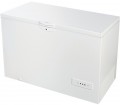Capacity
The total working volume of the freezer compartment. A larger volume allows for more products to be stored, but it affects the size and cost of the unit; therefore, when choosing based on this parameter, it's important not to chase maximum capacity but to consider what volume you actually need. For example, for household use, the average necessary volume is 50 liters per person; and when choosing a display freezer (see "Type"), you need to consider the number of products to be sold. More detailed recommendations for selecting the optimal volume can be found in specialized sources.
It is also worth considering that the freezer is often divided into several compartments (see below) — which means that a large volume does not necessarily guarantee that large pieces of products can fit into the device.
Hanging baskets
One or more removable baskets that are attached to the top of the freezer compartment.
Hanging baskets are made of both metal and plastic and are designed to store shallow frozen items or frequently used products that require quick access. Hanging baskets are also used to separate different types of contents.
Minimum temperature
The lowest temperature that the freezer can maintain in normal operation. First of all, the duration of food storage in the freezer depends on this parameter: it is believed that a temperature of -12 ° C is enough to preserve food for a month, -18 ° C – 3 months, -24 ° C – up to a year. At the same time, it must be taken into account that not only temperature affects the shelf life but also the type of product and its quality before freezing.
Power failure autonomy
The amount of time the freezer keeps food cold enough when the refrigeration system is turned off, for example, due to a breakdown or power outage. Technically, the power failure autonomy for each model is calculated differently; For example, for a freezer with an operating temperature of -18 ° C, this is the period during which the products in the chamber heat up from -18 ° C to -9 ° C. To sum up, the time is indicated during which the frozen products are guaranteed not to heat up to a temperature at which they could lose their properties.
Freeze capacity
One of the main indicators of freezer performance is the approximate amount of fresh food that the freezer can completely freeze from room temperature to the minimum operating temperature in 24 hours. For domestic use, a power of 10-15 kg/day is considered quite sufficient. More performant models may be required if you have to freeze a lot of food at a time or for industrial purposes.
Energy class (new)
This parameter shows the efficiency of electricity consumption by the freezer. Classes are designated in Latin letters from A to G, in ascending order of energy consumption. It was originally conceived until more energy-efficient models pulled up to class A, which eventually received the marking A+, A++, and A+++. Further development of technology has made it possible to go even further and, in order not to produce pluses in energy efficiency labelling, in March 2021, manufacturers returned to the previous indices from G to A, where A is the most energy-efficient freezer. Accordingly, the 2021 models will have modern markings, while older models will be marked the old way.
Energy consumption per year
It is the average amount of energy consumed by the freezer in a year of operation. Of course, these figures are not absolutely accurate. The actual power consumption may vary depending on the specific operating conditions. However, this parameter makes it possible to evaluate the consumption of the device and compare different models with each other. At the same time, it often turns out to be more convenient and visual than the energy consumption class (see above) because, in this paragraph, we are talking about a specific figure (from which you can also calculate the cost of electricity consumed).
Operation at sub-zero temperatures
The ability of freezer to work at sub-zero temperatures allows you to take it out to an unheated room. And chest freezers can be used outdoors.
Noise level
The average noise level generated by the freezer during operation. The quietest models give out about 25 - 30 dB — this is the average noise background in a residential area at night (comparable to the ticking of a wall clock); the loudest — is about 60 dB (loud conversation). More detailed comparison tables can be found in special sources.
In any case, the lower the noise level, the more comfortable the use of the unit. However, it does not always make sense to look for the
quietest freezer: in some situations (for example, in a noisy workshop), the freezer's sound may be lost against the surrounding noise background. In addition, reduced noise often affects the price.

